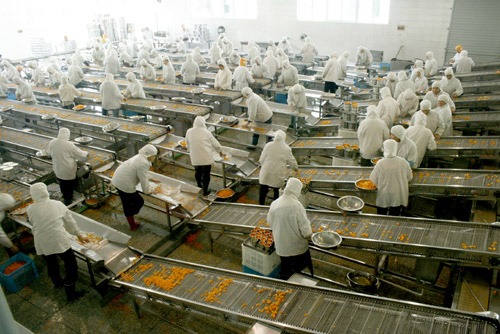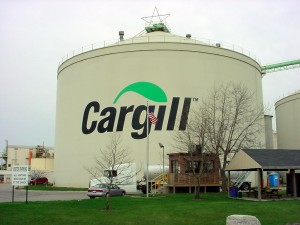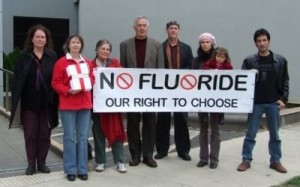Pharmaceutical drug contamination of waterways threatens life on our planet:
The President's Cancer Panel (PCP) recently released its
yearly report to the President outlining the status of cancer in America. This year's report focuses primarily on environmental factors that contribute to cancer risk. According to the report, pharmaceutical drugs are a serious environmental pollutant, particularly in the way they continue to contaminate waterways across the country (and the world).
Many reports have recently appeared about pharmaceutical contamination of water supplies, rivers, lakes and other waterways, but spokespersons from the drug and chemical industries have denied that this pollution poses any risk whatsoever to the environment. But this report, issued directly from PCP, provides a stunning indictment of the dangers associated with pharmaceutical pollution.
The executive summary of the PCP report includes the following statements:
"[P]harmaceuticals have become a considerable source of environmental contamination. Drugs of all types enter the water supply when they are excreted or improperly disposed of; the health impact of long-term exposure to varying mixtures of these compounds is unknown."
It's important to note that PCP is required by law to assess the National Cancer Program and offer a truthful evaluation of the various things it finds to be responsible for causing cancer. The panel is a division of the National Cancer Institute itself, so its findings hold fairly considerable weight in the scientific world (or they should, if the reaction wasn't so politicized).
The report itself is quite extensive, evaluating everything from the environmental and health impacts of drug and pesticide pollution to cell phone radiation and nuclear testing residue. But the section on pharmaceutical drugs is especially interesting when considering the fact that numerous reports have shown that drugs and drug residue that ends up in water supplies typically isn't filtered out by municipal treatment plants.
No laws exist to protect the public from pharmaceuticals
Many chemicals are highly regulated because they are known to negatively affect human and environmental health. The U.S. Environmental Protection Agency (EPA) is tasked with regulating exposure to these chemicals, but
pharmaceuticals are not included in its regulatory scheme. Despite years of prodding by environmental scientists, the EPA has given very little attention to the dangers posed by widespread pharmaceutical contamination.
According to
a U.S. Geological Survey (USGS) study conducted back in 2002, antidepressants, blood pressure and diabetes medications, anticonvulsants, oral contraceptives, hormone replacement therapy drugs, chemotherapy drugs, antibiotics, heart medications and even codeine are all showing up in the water supplies of American cities. This study was the first national-scale evaluation of pharmaceutical drug contamination in streams, and roughly 80 percent of the streams tested were found to be contaminated as well.
In 2008,
an AP investigation found that at least 46 million Americans are drinking water contaminated with trace amounts of pharmaceuticals. Even though every city tested has its water treated and "purified" prior to being delivered to the public, trace amounts of pharmaceutical drugs are making their way through to the tap. (Since not all major metropolitan areas were tested, the number of people affected is likely far higher than what was reported by AP.)
In spite of all this, water quality reports don't disclose the levels of pharmaceuticals found in tap water. Since the EPA and FDA have failed to establish any proper guidelines for drug contamination in water, most people have no idea that their water contains a dangerous cocktail of prescription medications.
Hospitals, consumers and drug companies are all responsible
None of this is surprising if you consider that unused and expired drugs cannot be legally returned to the pharmacies where they were purchased. Many people just flush them down the toilet because the drug labels actually encourage patients to dispose of them this way (and they probably don't know what else to do with them).
People who take prescription and over-the-counter drugs will excrete them as well, contributing to the drug overload being found at wastewater treatment plants. (Drugs are not necessarily "broken down" by your digestive system.)
It is also regular protocol for hospitals to flush
millions of pounds of unused medications every year, a practice that contributes significantly to water contamination.
And let's not forget the drug companies that dump large amounts of their own pharmaceuticals into water supplies. The same AP investigation found that more than
270 million pounds of pharmaceutical compound residue is dumped every year into waterways nationwide, many of which serve as drinking water for millions of people.
The U.S. isn't the only place where Big Pharma is dumping its waste, either. In 2009, researchers found that
India's rivers are full of dangerous pharmaceuticals, too.One Indian river where 90 different pharmaceutical companies dump their waste tested positive for over 21 active drug ingredients. In one river alone, there was enough ciprofloxacin (a strong antibiotic) being dumped every day by drug companies to treat 90,000 people! (And scientists detected this in water that was supposedly purified by the drug companies before being released into the environment).
The drug contamination levels found in India's rivers were 150 times the detected levels found in the U.S. These findings prove that drug companies couldn't care less how much drug residue they dump in water as long as they can get away with it. They don't even believe that pharmaceutical contamination is a threat to the environment.
"Based on what we now know, I would say we find there's little or no risk from pharmaceuticals in the environment to human health," explained microbiologist Thomas White, a consultant for the Pharmaceutical Research and Manufacturers of America, in
a Dallas Morning News article about the AP investigation. This is similar to BP's CEO saying, after the Deepwater Horizon explosion, that the amount of oil gushing into the Gulf of Mexico was "tiny" compared to how big the ocean is.
Studies show drug residue cocktails actually do cause harm
Though the chemical and drug industries deny any danger from exposure to drug residue in the water, science (and common sense) says otherwise.
A
2006 study conducted by researchers from the University of Insubria in Italy simulated drug-tainted water by creating a low-level mixture of various drug residues and testing it on embryonic cells. They discovered that, even at low doses, the drug residues actually stopped cells from reproducing.
Even though current water contamination levels are measured in parts per million or parts per billion, there is no way to know just how much exposure people are actually experiencing. People drink contaminated water, shower in contaminated water and cook with contaminated water, so it's illogical to suggest that there's no harm being caused by widespread exposure, even at "low" doses, especially when the exposure is a
combination of dozens of different drugs that have never been tested in combination.
People are not the only beings that are affected by pharmaceutical contamination, either. The world's aquatic ecosystems (and the plants and animals that belong to them) are all being negatively impacted.
Drugs are being found in fish
According to
an MSNBC report back in 2009, all kinds of drugs are being found in the bodies of fish near major U.S. cities. Researchers found drugs for high cholesterol, allergies, high blood pressure, bipolar disorder and depression in the livers and tissue of fish.
Researchers are in agreement that aquatic species of all types are being harmed by continuous exposure to water contaminated with pharmaceuticals. Even though wastewater is treated in the U.S. before entering waterways, most treatment facilities do not have the proper filtering technology to remove dangerous drug residues from wastewater before it gets dumped.
Many fish are experiencing reproductive problems as a result of exposure, as is explained in the following report:
(
http://www.msnbc.msn.com/id/23504633/)
Beyond having their sperm damaged, some fish are actually changing sexes. Males are becoming females and females are becoming males as a result of drug exposure in the water. Other water creatures are experiencing things like organ failure and the inability to grow. It makes a reasonable person ask "How long until these effects start to hit humans?"
Or have they already?
"We have no reason to think that this is a unique situation. We find pretty much anywhere we look, these compounds are ubiquitous," explained Erik Orsak, an environmental contaminants specialist with the U.S. Fish and Wildlife Service, in response to the findings.
And it's not just near American cities where fish are turning up with all kinds of drugs in their bodies. As of 2008, more than 100 different pharmaceutical compounds have been detected around the world, affecting fish and wildlife everywhere. These are chemicals that simply do not belong in our environment. And yet they are there, dumped into our waters by the pharmaceutical industry and its hospitals, pharmacies and consumers.
Why we need more research on the toxicity of pharmaceutical contaminants
Many animal studies have been or are being conducted on pharmaceutical exposure, and they are indicating that these drugs are causing widespread harm. But very few official human trials have been conducted, prompting many to push for increased efforts.
If drug residue is building up in animals and wildlife, then of course it's building up in humans as well, posing the risk of significant harm. Reproductive failure, thyroid dysfunction, cancer, osteoporosis -- all of these diseases and more may be caused, at least in part, by prolonged exposure to low levels of all sorts of drugs in the water supply.
Many states pushing for drug waste legislation
Because the truth about drug contamination in water is no longer a secret, many states have begun enacting legislation to regulate drug disposal. Last August,
Illinois passed the Safe Pharmaceuticals Disposal Act, which restricts hospitals from flushing drugs down the drain.
California has a similar law in place, and New York is working on one as well, according to a recent report:
(
http://www.westfaironline.com/hudso...)
The same report indicates that there have been five bills introduced to regulate drugs at the federal level.
While this addresses the hospital waste problem, there's still the human and drug company waste problems. No matter how you look at it, pharmaceutical drugs are going to continue making their way into the water supplies because
they will pass through the bodies of consumers first!Drug companies must be held responsible for their wastewater
Since it's already been revealed that drug companies are failing to properly treat their wastewater before dumping it into rivers (even though they claim to be treating it), U.S. regulatory agencies need to step up and correct the problem. Regular monitoring of wastewater contaminant levels is the only way to halt the chemical contamination of waterways.
And if U.S. companies are polluting water supplies in other countries (such as India), they should be held accountable for their actions. There's no excuse for U.S. companies to pollute anywhere in the world just because they're operating outside domestic borders.
Wastewater treatment plants should be retrofitted
State and local legislators would do well to put forth their own legislation to upgrade wastewater treatment facilities so they can properly filter out pharmaceuticals (and dispose of them safely). Since there's no way to stop human elimination of pharmaceuticals (apart from slowly educating the masses to stop swallowing dangerous pharmaceuticals), municipalities need to do their part to prevent these dangerous toxins from getting into water supplies in the first place.
Together, these measures would help to drastically reduce the amount of pharmaceutical waste entering our environment.
It's the environment, stupid!
The careless disposal of toxic pharmaceuticals is proving to be highly destructive, despite reassurances by some that it's not that big of a deal. The health of the planet and all of its amazing biodiversity is now threatened by the steady poisoning of toxic chemical pharmaceuticals.
And it's not just pharmaceuticals, either. Chemical byproducts and waste from many different industries are polluting our environment at unprecedented rates. Mercury (from dental fillings), fluoride (dripped into the public water supply
on purpose, if you can believe that!), and all sorts of other chemicals and heavy metals are showing up in food, water and the global environment.
Haven't we poisoned our planet enough already?
Plants, animals and even humans can only take so much of this. That's why we need to keep fighting against the corporations that are causing this harm and force them to stop destroying the world in which we hope to raise our children.
After all, if we keep poisoning the planet at this rate, there won't be much left to offer future generations except a toxic stew of patent-protected chemicals that all the corporations pretend pose no problem at all.










Your Body Probably Contains Over 200 Chemicals
Five Top Common Chemicals to Avoid …
What Else Can You do to Reduce Unnecessary Chemical Exposure to Your Family?